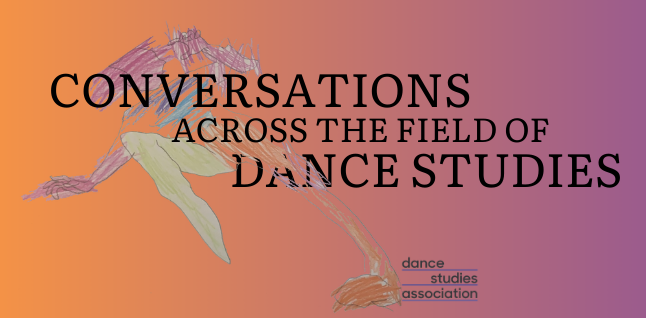Liner Notes: Joseph Schloss
There are several themes that really stood out to me in this conversation.
First, it is common in Hip Hop Studies to draw a basic distinction—either explicitly or implicitly—between “mainstream” hip hop (generally associated with commercialism and mass media) and “underground” hip hop (generally associated with a more personal, grassroots orientation).1 But that distinction just doesn’t apply to dance. Not only is this an important conceptual point for understanding these dance forms, but it is also a significant intervention that Dance Studies can offer Hip Hop Studies generally. What kinds of practices, relationships, and philosophies may come into clearer view when we no longer expect them to come down on one side or the other of this false divide?
Second, it is apparent that hip hop dance pedagogy is often a matter of teaching people how to learn for themselves, as opposed to teaching them to follow instructions. This is largely a result of the cultural environment in which hip hop dance developed, and it involves a wide range of perceptual, cognitive, and kinesthetic processes. Buddha Stretch and Ms. Vee both speak at length about how hip hop dance developed in a time and place where resources like video recordings were simply not available. Moreover, even when dancers had the means and opportunity to teach their moves to others, they were often unwilling to do so.
As a result, one of the foundational learning tools of hip hop dance is the ability to memorize and reconstruct a movement based on a single viewing. This, in turn, requires what the speakers refer to as “four-dimensional” memory. Students must not only be able to comprehend and remember the move in three spatial dimensions, but they must also understand the way it unfolds over time. Moreover, even if they are able to develop this knowledge after a single viewing, students must still develop the ability to reproduce the movement with their own body. And even once all of that is achieved, the result is still only an understanding of the movement itself as a physical act, stripped of its social, cultural, historical, and emotional contexts. It is not surprising, then, that both Ms. Vee and Buddha Stretch place a great deal of emphasis on teaching this context. Before the widespread availability of hip hop dance videos on various streaming platforms, that was automatically part of any hip hop dance education, simply because there was no way to learn the movements without personally engaging with members of the community. The teaching environment and the social context were one and the same.
Finally, I think it is instructive that rather than reject the use of streaming video on these grounds, both speakers choose to address this issue by thinking creatively about how these new resources can be leveraged to still serve the original goals, such as by providing direct access to archival footage and rare recordings. As hip hop has always done, they choose to embrace new technologies and approaches, and then reconfigure them to suit their own needs. Although the simultaneous embrace of traditionalism and innovation is not unique to hip hop culture, hip hop is rarely given credit for the sophistication with which it balances these two imperatives. This conversation, in my opinion, is an ideal example of how this powerful dynamic is not just maintained but also actively reinforced.
Author Biography
Joseph Schloss is an interdisciplinary scholar who studies the way people use art—especially music and dance—to develop new perspectives on social, cultural, and political issues. He is primarily interested in hip hop culture as part of a larger complex of expressive traditions of the African diaspora. A past recipient of the Society for Ethnomusicology’s Charles Seeger Prize, he is the author of Foundation: B-Boys, B-Girls and Hip-Hop Culture in New York (Oxford University Press, 2009) and Making Beats: The Art of Sample-Based Hip-Hop (Wesleyan University Press, 2004/2014), which won the International Association for the Study of Popular Music Book Prize in 2005. He currently teaches at Princeton University and the City University of New York.
Notes
- The “underground” versus “mainstream” distinction emerged from the hip hop community as part of a larger authenticity discourse in the 1990s. As hip hop music became more commercially viable, many artists and fans felt an increased pressure to take a position on whether hip hop should become a form of commercialized popular music or whether it should remain a community-based art form. In this context, self-identification as an “underground” rap artist—or rap fan—was a way to publically align oneself with the latter position. Many academics who studied rap music adopted this distinction, either because they felt that the conversation itself was worthy of critical attention as a social phenomenon (e.g. Rose, 2008; Harrison, 2009) or because the term “underground” served as a useful shorthand for an artistic agenda that emphasized concepts of authenticity (e.g. Belle, 2014; Saunders, 2015). My point here is twofold. First, precisely because the distinction has been so valuable to the discourse around music, scholars may not realize that it doesn’t necessarily apply to other elements of hip hop, such as dance. And, second, that blind spot is itself evidence of how dance and other non-rap elements of hip hop have been marginalized in the academy. ⮭
Sources
Belle, Crystal. (2014). From jay-Z to dead prez: Examining representations of black masculinity in mainstream versus underground hip-hop Music. Journal of Black Studies, 45(4), 287–300.
Harrison, Anthony Kwame. (2009). Hip-Hop underground: The integrity and ethics of racial identification. Temple University Press.
Rose, Tricia. (2008). The hip-hop wars: What we talk about when we talk about hip-hop – and why it matters. Basic Books.
Saunders, Tanya L. (2015). Cuban underground hip hop: Black thoughts, black revolution, black modernity. University of Texas Press.
